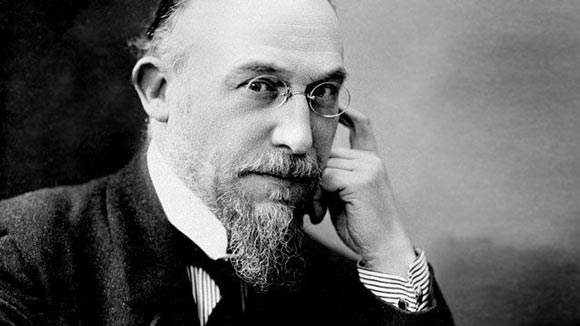
Éric Alfred Leslie Satie was a French pianist and avant-garde composer. He was also famous for being an author, some of his most famous works were published in “Vanity Fair” and “Dadaist 391”.
Erik Satie was born on May 17, 1866 in Honfleur, Normandy. At the age of six, the young Satie was forced to move to his paternal grandparent’s house upon the news of his mother’s death. There, his grandparents arranged for his first lessons in music. These lessons continued until age twelve, after which the young Satie reunited with his father, who had now married a piano teacher. Satie then continued his music education with his stepmother and at the age of thirteen, he joined the famous Paris Conservatoire. However, his time at the Conservatoire was not be easy, as his teachers severely disliked his playing style. His teachers often remarked that he was “the laziest student in the Conservatoire”. Satie, dissatisfied with his time at the Conservatoire left it to serve for a year in the army. However, his teachers at the Conservatoire who suggested to him to take up composition.
Satie’s father published three of Satie’s works in 1886. They were titled “Elegie”, “Trois Melodies” and “Chanson”. Satie soon followed up his initial compositions with more eccentric works such as “Gymnopedies”, ”Ogives”, and “Gnossiennes”. In 1887 Satie befriended the famous French Impressionist Composer Claude Debussy, and the two often discussed the latest trends in music. Satie also found inspiration from the artistic gatherings at the famous “Le Chat Noir Café-Cabaret”. However, this was a difficult time for Satie financially. He survived as a cabaret pianist, adapting popular music for the piano. During this period, Satie wrote the music for a pantomime by Jules Depaquit titled “Jack in the Box”.
In 1905, Satie decided to try his luck at counterpoint. He enrolled in the Schola Cantorum de Paris under Vincent d’Indy. His newfound efforts to better himself served as a precursor to his celebrity status. By 1912, Satie partnered with the Spanish Pianist Robert Vines to release a serious of humorous piano shorts. These piano shorts showered Satie with praise and attention, and it led people to investigate and rediscover many of Satie’s lost works. This era saw one of his earliest works, Gymnopedies, earn plenty of praise and acclaim. Satie also had the French Composer Maurice Ravel to thank for much of his fame, as he pointed out Satie’s genius to France’s elite.
Post 1912 Satie wrote a number of orchestral and instrumental works. In 1918 he wrote the “Musique d’ameublement”, and in 1914 he wrote the “Autre Choral”. He also wrote ten dramatic pieces after 1912. In 1917, he wrote one of his largest vocal works, the “Socrate: Drame Symphonique”.
Erik Satie died on July 1, 1925 in Paris, France. He developed the cirrhosis of the liver, together with pleurisy, which claimed his life. Satie received the last rites of the Catholic Church in his death bed. In his honor, a tiny stone monument has been erected. Satie received plenty of posthumous attention, his friends and colleagues discovered many of his works that remained unpublished. This included the orchestral score to “Parade”, “Vexations”, and many additions to “The Dreamy Fish” and the Schola Cantorum Exercises.